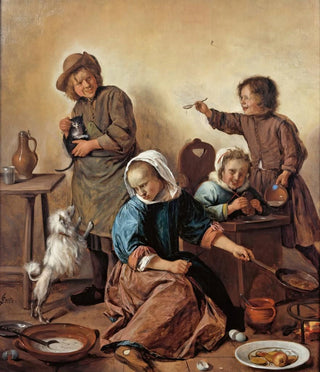Art print | The children's meal - Jan Steen


View from behind

Frame (optional)
In the vast panorama of Dutch art history, the artwork "The Children's Meal" by Jan Steen stands out for its liveliness and its ability to capture the very essence of everyday life in the 17th century. This canvas, rich in detail and color, immerses us in a family scene where children's carefree innocence contrasts with adults' concerns. Steen, master of visual storytelling, manages to immortalize a fleeting moment, where children's laughter echoes within a domestic setting. Through this art print, the artist invites us to explore the subtleties of childhood while revealing the social dynamics of his time.
Style and uniqueness of the work
Jan Steen's style is characterized by striking realism and a keen sense of composition. In "The Children's Meal," he uses a vibrant color palette to animate the scene, with each character carefully positioned to create a lively tableau. The light, playing on faces and objects, enhances the warm atmosphere of this convivial moment. Steen does not merely depict children eating; he captures emotions, gestures, and even subtle interactions that tell a story. The expressions of the children, between joy and mischief, blend with those of the adults, offering a glimpse into the family relationships of the period. This painting is a true ode to life, where every detail matters and contributes to the whole.
The artist and his influence
Jan Steen, born in Leiden in 1626, is one of the most emblematic painters of the Dutch Golden Age. His career, marked by numerous genre scenes, testifies to a meticulous observation of society of his time. Steen was not only a talented painter but also an exceptional storyteller, capable of capturing moments of life with rare emotional depth. His influence is evident in the development of genre painting, inspiring many artists to explore everyday life with a critical and humorous eye. Through his works, he addresses universal themes such as family, education, and morality, while offering a reflection on the customs of his era. "The Children's Meal" is part of

Matte finish

View from behind

Frame (optional)
In the vast panorama of Dutch art history, the artwork "The Children's Meal" by Jan Steen stands out for its liveliness and its ability to capture the very essence of everyday life in the 17th century. This canvas, rich in detail and color, immerses us in a family scene where children's carefree innocence contrasts with adults' concerns. Steen, master of visual storytelling, manages to immortalize a fleeting moment, where children's laughter echoes within a domestic setting. Through this art print, the artist invites us to explore the subtleties of childhood while revealing the social dynamics of his time.
Style and uniqueness of the work
Jan Steen's style is characterized by striking realism and a keen sense of composition. In "The Children's Meal," he uses a vibrant color palette to animate the scene, with each character carefully positioned to create a lively tableau. The light, playing on faces and objects, enhances the warm atmosphere of this convivial moment. Steen does not merely depict children eating; he captures emotions, gestures, and even subtle interactions that tell a story. The expressions of the children, between joy and mischief, blend with those of the adults, offering a glimpse into the family relationships of the period. This painting is a true ode to life, where every detail matters and contributes to the whole.
The artist and his influence
Jan Steen, born in Leiden in 1626, is one of the most emblematic painters of the Dutch Golden Age. His career, marked by numerous genre scenes, testifies to a meticulous observation of society of his time. Steen was not only a talented painter but also an exceptional storyteller, capable of capturing moments of life with rare emotional depth. His influence is evident in the development of genre painting, inspiring many artists to explore everyday life with a critical and humorous eye. Through his works, he addresses universal themes such as family, education, and morality, while offering a reflection on the customs of his era. "The Children's Meal" is part of






